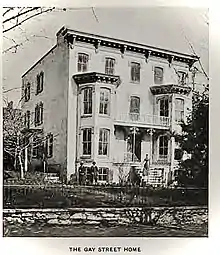Angeline Stickney
Chloe Angeline Stickney Hall (November 1, 1830 – July 3, 1892) was an American academic, suffragist, and mathematician. She was a teacher and later the wife of astronomer Asaph Hall. She did not use her first name and so was known as Angeline Stickney Hall. Stickney, the largest crater on Phobos, is named after her in recognition of her support for the satellite's discovery.
Angeline Stickney | |
|---|---|
 | |
| Born | November 1, 1830 |
| Died | July 3, 1892 (aged 61) |
| Nationality | American |
| Alma mater | New-York Central College |
| Occupation | Teacher, suffragist, and mathematician |
| Spouse(s) | Asaph Hall |
Life
Angeline Stickney was born to Theophilus Stickney and Electa Cook on November 1, 1830. In 1847 she took three terms of study funded by her cousin, Harriette Downs, at Rodman Union Seminary.[1] Stickney was able to attend New-York Central College[2]:219 with help from her sister Ruth and by teaching at the college. She majored in science and mathematics, doing coursework in calculus and mathematical astronomy, and graduated with the college's first class, in 1855.[3] New-York Central College was a progressive school where students of modest means, including women and free African Americans, could earn a college degree. It was here that she became passionate about the causes of women's suffrage and the abolition of slavery.
Angeline Stickney and Asaph Hall met at Central College. Stickney was two years ahead of Hall. She was his instructor in geometry and German.[4] During their days together as teacher and student, Hall and his classmates would devise questions and problems that they were convinced Stickney could not solve, yet she never failed to solve them.[5]
Stickney[5] and Hall married in Elkhorn, Wisconsin, on March 31, 1856. As was common at the time, she had to give up her academic career after the wedding.[5] Immediately after the wedding, the couple moved to Ann Arbor, Michigan, so that Hall could continue his education at the University of Michigan. Three months later, they moved to Shalersville, Ohio.[4] It was Stickney who communicated with her husband's employer, Captain Gillis, and successfully suggested that he should be made a professor at the Naval Observatory.[5]

She encouraged him to continue his search for satellites of Mars when he was ready to give up, and he successfully discovered the moons Phobos and Deimos.[6][1]:112 However, when she asked for payment equal to a man's salary for her calculations, Asaph refused, so Angeline then discontinued her work.[5]
The largest crater on Phobos, Stickney Crater, is named after her.[6]
Hall home-schooled all four of her children, and all attended Harvard University. Her third son, Angelo Hall, a Unitarian minister, wrote her biography.[1] Her oldest son, Asaph Hall, Jr., was born on October 6, 1859, and served as director of the Detroit Observatory from 1892 to 1905. Other sons were named Samuel (second son) and Percival (fourth son); Percival Hall (1872–1953) was the second president of Gallaudet University from 1910 to 1946 (he himself was not deaf).
She died at North Andover, Massachusetts, at age 61.
Further reading
- "Chloe Angeline Stickney Hall". The Contributions of Women to the United States Naval Observatory: The Early Years. United States Naval Observatory. 14 November 2011. Archived from the original on 26 August 2012. Retrieved 19 May 2014.
References
- Hall, Angelo (1908). An Astronomer's Wife: The Biography of Angeline Hall. Baltimore: Nunn & Company.
- Dick, Steven J. (2003). Sky and Ocean Joined: The US Naval Observatory 1830-2000. Cambridge University Press. ISBN 978-0-521-81599-4.
- "College Commencements. New York Central College". New-York Tribune. 6 Aug 1855. p. 3 – via newspapers.com.
- Whitesell, Patricia S. "Detroit Observatory: nineteenth-century training ground for astronomers" (PDF). Journal of Astronomical History and Heritage. 6 (2): 69–106. Archived from the original (PDF) on 16 December 2005. Retrieved 19 May 2014.
- "Famous wife Hall". maia.usno.navy.mil. Archived from the original on 2012-08-26. Retrieved 2016-11-12.
- Rothery, David A. (2015-11-26). Moons: A Very Short Introduction. Oxford University Press. ISBN 9780191054211.